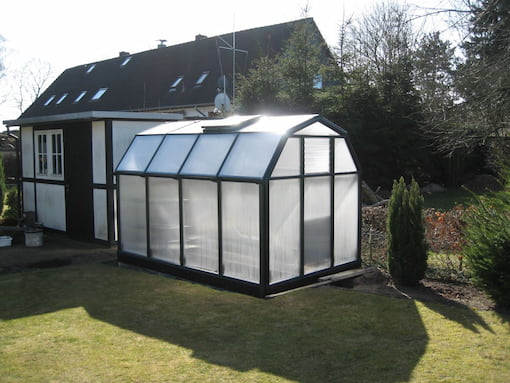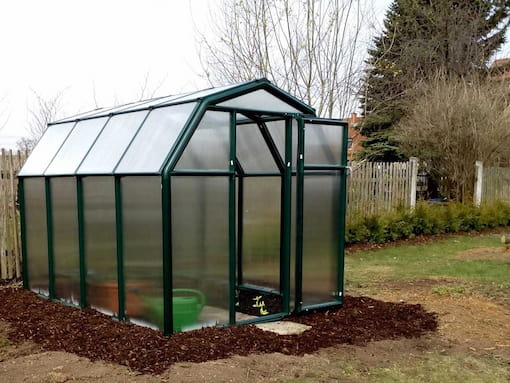Last updated on October 23rd, 2023 at 09:04 pm
Sun-ripened vegetables in summer and frost-protected plants in winter: For your greenhouse to serve its purpose optimally, you need to find the best location for a greenhouse in your garden. Take a look at the most important location factors with us.
Contents
- 1 Location factors for the greenhouse
- 2 The perfect location for the greenhouse
- 3 Can a greenhouse be placed under a tree?
- 4 In which compass direction should I place the greenhouse?
- 5 Why is the right greenhouse location so important?
- 6 Which location is best for the greenhouse?
- 7 Can greenhouses be placed in the shade?
- 8 Author
Location factors for the greenhouse
Your greenhouse should naturally fit in well with your garden and be easily accessible. However, don’t choose the location solely for looks and convenience. After all, the location will have an impact on how well the greenhouse performs. You should not forget this when choosing a location:

Solar radiation
A greenhouse should capture light, produce heat, and transmit both to the plants inside. Therefore, the light output is a main argument for or against possible locations. So choose the location of your greenhouse so that, if possible, sunlight falls on it all day and sufficient heat is also produced in the morning and evening hours. At the same time, there should be no overheating during the hot midday hours so that the plants do not dry out. You can avoid this, for example, by regular ventilation and adequate watering.
By the way, light conditions change throughout the year. In summer, the sun is high in the sky, surrounding trees as well as buildings cast only short shadows and the light yield is usually high. In winter, on the other hand, the sun’s rays hit the earth at a flatter angle of incidence, the shadows become longer and the light yield is lower. Include this consideration in your site selection as well.
Orientation
As mentioned earlier, the position of the sun changes throughout the year. In winter and spring, the sun tends to be low and the side walls of the greenhouse receive more sun than the roof section. If you want to use your greenhouse to overwinter frost-sensitive plants or to grow plants in the spring, it is recommended that the longitudinal axis be oriented east-west along the sun’s path. This allows the sun to penetrate the greenhouse wall throughout the day.
Would you rather harvest vegetables or grow tropical flowers in the greenhouse during the summer months? Then a north-south orientation of the longitudinal axis is recommended. This way, the light will best enter through the roof from above during the day.
Wind
A constant flow of air around the greenhouse exposes the plants to constant drafts. You can avoid this either by providing good insulation or by locating the greenhouse away from the wind. Make sure there are wind breakers near the greenhouse. These can be individual bushes, small hedges, or privacy walls that protect the greenhouse from the full force of the wind. However, the windbreakers should not be too high, so that they do not cast shadows on the greenhouse.
Proximity to trees or buildings
While trees and buildings may protect the greenhouse from strong winds, they also cast shadows and reduce light output. In this regard, deciduous trees are usually less critical than conifers. This is because deciduous trees provide some shade during the hot months, regulating the temperature inside the greenhouse, which is desirable depending on the planting.
However, in winter they lose their leaves unlike conifers, which also cast a lot of shade in the cold months and block the sunlight they need.

In addition, falling branches pose a risk to the greenhouse glazing, and fallen leaves or needles contaminate the transparent surface. This reduces light transmission and increases maintenance and cleaning requirements.
Also note that walls and buildings that are very close to the greenhouse hinder air circulation. This promotes moss growth and is also associated with increased cleaning requirements.
So when it comes to proximity to trees and buildings, the following applies in terms of wind protection, shade and soiling: as close as necessary, as far away as possible.
Observe minimum distance to property lineObserve minimum distance to property line
Proximity to power and water supply
If you want to counteract the risk of dehydration or hypothermia with irrigation, automatic ventilation and heating, you need access to electricity and water. For this, it is advisable to place the greenhouse close to your home so that you do not have to lay long supply lines.
Slope
If it is possible in your garden, you should avoid placing your greenhouse on a slope. This is because in winter, cold air usually flows down the slope, collects there, and envelops the greenhouse. This increases the risk of frost, which you can counter only with expensive heating.
In addition, water running down the slope can cause waterlogging, which poses a risk to the greenhouse and plants. In this case, install a drainage system.
Legal regulations
In addition to environmental factors, legal regulations impact the potential location of your greenhouse. Even if you don’t need a building permit for your greenhouse, there may be certain regulations depending on the county and municipality. Consult the zoning map and make sure there are no restrictions on building in the garden, such as a minimum distance from the property line.
And if the greenhouse is to be located close to the property line, it is also advisable to clarify any objections with the neighbor in order to maintain neighborly peace.
The perfect location for the greenhouse
Sufficient sun at any time of the year, protected from the wind, not too close to trees, buildings and slopes, easily accessible from the home and within legal regulations: you have found the perfect location for your greenhouse. Then you can start the construction and soon grow the first plants in your new greenhouse. We wish you much joy in the process!
Frequently asked questions
Here you will find answers to questions we are frequently asked.
Can a greenhouse be placed under a tree?
If possible, a greenhouse should not be placed directly under a tree. Trees cast shade and thus reduce the effectiveness of the greenhouse.
In addition, falling branches can cause damage. In addition, fallen leaves and needles pollute the outside of the greenhouse.
In which compass direction should I place the greenhouse?
If you want to use your greenhouse in winter and spring, the long side should be oriented along the east-west axis.
If you prefer planting in the summer months, a north-south orientation is recommended.
Why is the right greenhouse location so important?
The location determines how well the greenhouse will perform.
Depending on the location in the garden, solar radiation and light yield differ, as well as the influence of wind, shade, cold and humidity.
Depending on how you want to plant your greenhouse, different location factors play a role.
Which location is best for the greenhouse?
Which location is best depends on the planting.
Basically, however, the light yield should be large, little wind should go and a certain distance to high trees, buildings and slopes should be maintained.
Can greenhouses be placed in the shade?
Greenhouses should not be completely shaded, as they are designed to trap light and heat up as a result.
However, a little shade – especially on hot days in the summer – can protect plants from overheating and drying out.


